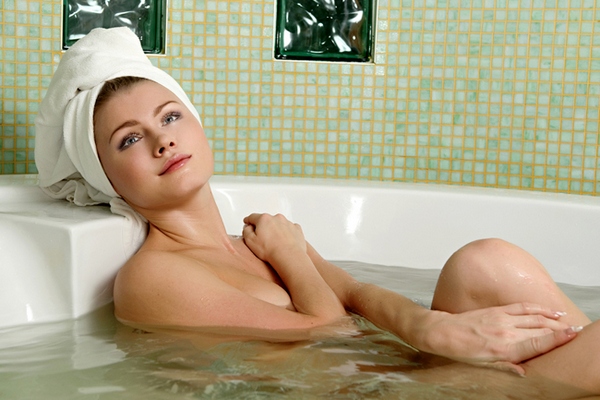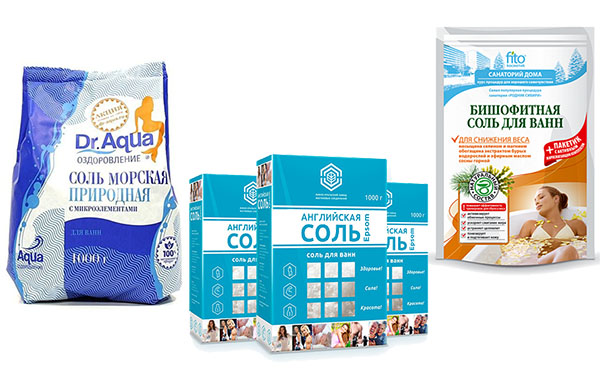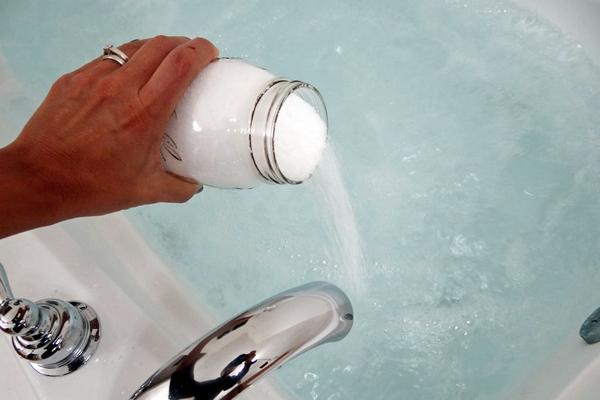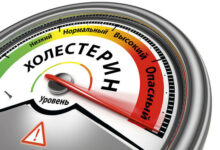- Procedure and Expected Outcome
- Mechanism of Action
- Contraindications of Baths
- Summary
Among the numerous home spa recipes, perhaps the baths with salt are one of the most popular. Really, this thing is quite affordable and enjoyable: half a kilo – a kilo of salt, 10-20 minutes of your time – and minus half a kilo of weight and along the way – strong nails and hair, fast metabolism. Is it that way? We’ll find out.
Procedure and Expected Outcome

The procedure of taking a bath with salt for weight loss is as follows:
- Take a shower, use a scrub.
- Take 500-1000 g of salt, dissolve it in a full bath. The water should be enough so that when you submerge it does not cover the heart area. The water temperature is 36-39 degrees. Stay in the bath for weight loss for 10 to 20 minutes, depending on your health.
- Thoroughly wipe yourself with a towel, do not rinse, wrap yourself in a blanket or a bedspread, and rest in this form for at least half an hour.
- Do not eat within two hours before and after the procedure. Drink water.
- A course of 10-15 procedures.
You can use both sea salt and rock, common salt. Most sources say that evaporated salt should not be used – supposedly it has a changed structure and a lack of useful components. The recipe is subject to variation. For example:
- Epsom salt baths: 100 g of magnesium sulfate (Epsom salt) is mixed with regular or sea salt in a ratio of 1 to 5;
- Baking soda salt baths: 500 g of salt + 250-500 g of soda (we previously discussed the effectiveness of soda baths for weight loss);
- Baths with essential oils: before dissolving the salt in the bathroom, add a few drops of essential oil to it. Suitable oils from grapefruit, orange, cedar.
What Salt Baths Promise
So here are the promised results of a home spa bath for weight loss:
- Instant weight loss of 300-500 g;
- Strengthening nails and hair;
- Removal of toxins and slags;
- Removal of excess cholesterol;
- Normalization of hormonal balance due to “useful microelements”, which supposedly “penetrate through the skin”;
- Disappearance of stretch marks and cellulite.
Well, it sounds all pleasant and promising. But how are things really?
Mechanism of Action

To understand how salt baths work for weight loss, it would be nice to make a small excursion into chemistry.
Lyrical Digression
If two solutions of different concentrations are separated by a semipermeable membrane – that is, a membrane that allows the passage of only solvent molecules – the solvent will move towards the solution with a higher concentration of dissolved substance. This phenomenon is referred to as “osmosis”, and the pressure created in this way is called osmotic.
It is the osmotic pressure that creates tissue elasticity in all living organisms, regulating the water exchange between the cell and the intercellular space. The membrane of any cell, in essence, is a semipermeable one: water molecules penetrate it by ordinary diffusion, and all other substances penetrate only through special channels with the help of carrier proteins.
A solution, the osmotic pressure of which is equal to the osmotic pressure of human blood plasma, is called isotonic. A solution with a higher osmolarity is called hypertonic, with a lower one – hypotonic. All intravenous solutions are isotonic, which is injected into a vein, so as not to cause the destruction of blood cells by dehydration or, conversely, by excessive water penetration.
Back to Baths for Weight Loss
Salt is sodium chloride by its chemical composition. And the basis of the solution in the bath will be exactly this: sodium ion and chlorine ion, regardless of whether it is a bath with kitchen salt from the nearest grocery store or something more exotic. Yes, in the natural sea salt, in addition, there will be iodine ions (also in the usual iodized salt), magnesium, potassium, bromine and other impurities. Some – for example, from the Dead Sea – will have more of them. Some – those obtained by evaporation – will have minimum impurities.
After dissolving the recommended amount of salt in an ordinary bath, even if it is half-filled or even a third (so that the water does not reach the heart area), a hypertonic solution is obtained in the bath. It begins to draw out intercellular fluid from the skin, carefully treated with a scrub (to cleanse the pores).
Such water loss in itself is not dangerous – if the human body were so easily susceptible to lethal dehydration, then mankind would have died out after the first swim in the sea. But some special benefit will not be from a bath with sea salt – like from any other. At least, less than the promised one.
Will the puffiness go away?
Yes, due to the removal of excess water – including sweat, since 38 degrees is already a little warmer than the body needs.
Will the cellulite go away?
Perhaps – a scrub before taking salt baths, removing excess fluid, active massage with a terry towel, and so on 10-15 times – an excellent course of anti-cellulite procedures.
Stretch marks?
Unlikely, only the very fresh ones can decrease, and old scars are in fact old scars, which require other methods of removal.
Nails will become stronger?
It is also possible, baths with a strong saline solution – a traditional remedy for brittle nails, however, no one has collected statistics. Hair – definitely not.
Will cholesterol be removed?
No, its molecule is too large to pass through the skin.
As for toxins and slags, everyone is talking about them, but no one can articulate what exactly they mean by these terms.
And there can be no question of any penetration of useful microelements through the pores, since water will move from the body, and not salts into the body.
Contraindications of Baths

Like any physiotherapy procedure, salt baths for weight loss have contraindications:
- Wounds and abrasions on the skin;
- Chronic cardiovascular insufficiency;
- Dry and sensitive skin;
- Lactation – dehydration can reduce milk production;
- Malignant neoplasms;
- Increased body temperature.
Very carefully you can take baths with salt during pregnancy: being in hot water can trigger a miscarriage. Being in water of a comfortable temperature during pregnancy is not contraindicated in principle.
The same goes for hypertensive patients or varicose veins: they are contraindicated to overheat, but no water procedures are prohibited in general. When rubbing the body after the bath, areas of varicose veins should be bypassed.
Summary
So what is the bottom line? Improved health after a pleasant water treatment; Removal of edema; Increase of skin tone. Perhaps a decrease in appetite if the procedure is carried out before bedtime (you can not eat for two hours before taking a bath). Slight weight loss due to dehydration, which will go away as soon as the water-salt metabolism returns to normal. That’s all the results.
Baths can be used as an auxiliary tool – to relax and slightly tighten the skin while losing weight. But it is useless to count on something more.



